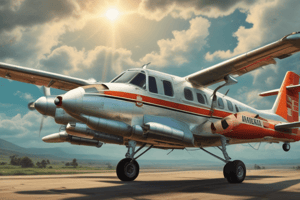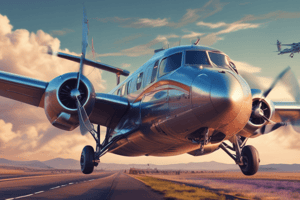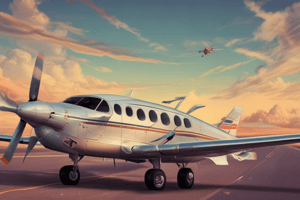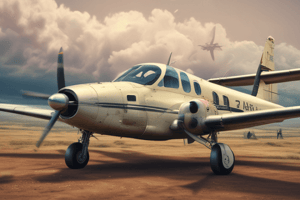Podcast
Questions and Answers
What is the primary danger of the 'leans' for pilots during flight?
What is the primary danger of the 'leans' for pilots during flight?
Which strategy is essential to avoid the 'graveyard spiral' during flight?
Which strategy is essential to avoid the 'graveyard spiral' during flight?
When experiencing spatial disorientation, what should a pilot prioritize?
When experiencing spatial disorientation, what should a pilot prioritize?
Practicing recovery from unusual flight attitudes is important because it helps to:
Practicing recovery from unusual flight attitudes is important because it helps to:
Signup and view all the answers
What can contribute significantly to airsickness during flight?
What can contribute significantly to airsickness during flight?
Signup and view all the answers
What should pilots do during periods of low visibility to enhance safety?
What should pilots do during periods of low visibility to enhance safety?
Signup and view all the answers
The sensation that the aircraft is tilted opposite to its actual bank is a description of which phenomenon?
The sensation that the aircraft is tilted opposite to its actual bank is a description of which phenomenon?
Signup and view all the answers
In the context of preventing airsickness, what is the role of understanding vestibular illusions?
In the context of preventing airsickness, what is the role of understanding vestibular illusions?
Signup and view all the answers
What might happen if a pilot experiences the 'graveyard spiral' and trusts their false sensations?
What might happen if a pilot experiences the 'graveyard spiral' and trusts their false sensations?
Signup and view all the answers
What is a recommended action when experiencing sudden head movements that could cause disorientation?
What is a recommended action when experiencing sudden head movements that could cause disorientation?
Signup and view all the answers
The phenomenon known as the 'leans' leads a pilot to feel as though the aircraft is banked more than it actually is.
The phenomenon known as the 'leans' leads a pilot to feel as though the aircraft is banked more than it actually is.
Signup and view all the answers
To counteract the 'graveyard spiral', it is crucial for pilots to trust their visual senses over their instruments.
To counteract the 'graveyard spiral', it is crucial for pilots to trust their visual senses over their instruments.
Signup and view all the answers
Practicing recovery from unusual flight attitudes can help pilots become more confident in their instrument flying skills.
Practicing recovery from unusual flight attitudes can help pilots become more confident in their instrument flying skills.
Signup and view all the answers
The 'graveyard spiral' can occur when a pilot thinks they are still turning after returning to level flight.
The 'graveyard spiral' can occur when a pilot thinks they are still turning after returning to level flight.
Signup and view all the answers
A lack of visual references significantly reduces a pilot's likelihood of experiencing spatial disorientation.
A lack of visual references significantly reduces a pilot's likelihood of experiencing spatial disorientation.
Signup and view all the answers
Sudden head movements should be encouraged when flying to ensure that pilots stay alert.
Sudden head movements should be encouraged when flying to ensure that pilots stay alert.
Signup and view all the answers
Using a systematic scanning method of cockpit instruments can help maintain an accurate perception of orientation.
Using a systematic scanning method of cockpit instruments can help maintain an accurate perception of orientation.
Signup and view all the answers
Airsickness can be effectively reduced by recognizing and understanding vestibular illusions.
Airsickness can be effectively reduced by recognizing and understanding vestibular illusions.
Signup and view all the answers
Transferring control to another pilot is recommended only in non-severe cases of spatial disorientation.
Transferring control to another pilot is recommended only in non-severe cases of spatial disorientation.
Signup and view all the answers
The recommended strategy during periods of low visibility is to trust flight sensations over instrument indications.
The recommended strategy during periods of low visibility is to trust flight sensations over instrument indications.
Signup and view all the answers
What immediate action should a pilot take upon realizing they are experiencing 'the leans'?
What immediate action should a pilot take upon realizing they are experiencing 'the leans'?
Signup and view all the answers
Describe how the 'graveyard spiral' can contribute to potential loss of control in an aircraft.
Describe how the 'graveyard spiral' can contribute to potential loss of control in an aircraft.
Signup and view all the answers
How can systematic scanning of cockpit instruments aid in preventing spatial disorientation?
How can systematic scanning of cockpit instruments aid in preventing spatial disorientation?
Signup and view all the answers
What is a critical preventive measure for pilots dealing with poor visibility conditions?
What is a critical preventive measure for pilots dealing with poor visibility conditions?
Signup and view all the answers
Explain why sudden head movements are discouraged in severe cases of spatial disorientation.
Explain why sudden head movements are discouraged in severe cases of spatial disorientation.
Signup and view all the answers
What role does practice with a flight instructor play in preventing disorientation during flight?
What role does practice with a flight instructor play in preventing disorientation during flight?
Signup and view all the answers
In what way does understanding vestibular illusions help pilots during flight?
In what way does understanding vestibular illusions help pilots during flight?
Signup and view all the answers
Why is transferring control to another pilot considered in cases of severe spatial disorientation?
Why is transferring control to another pilot considered in cases of severe spatial disorientation?
Signup and view all the answers
What compound effect can occur if a pilot continues to trust false sensations during the 'graveyard spiral'?
What compound effect can occur if a pilot continues to trust false sensations during the 'graveyard spiral'?
Signup and view all the answers
Identify a key strategy that pilots should employ when facing the risk of airsickness.
Identify a key strategy that pilots should employ when facing the risk of airsickness.
Signup and view all the answers
Study Notes
Fundamentals of Aeromedical Factors for Aspiring Pilots
- Emphasis on understanding spatial disorientation and airsickness for flight safety.
- Critical concerns include pilots' inability to interpret aircraft attitude, altitude, and airspeed.
- Equilibrium is maintained by the vestibular system, visual cues, and proprioceptive senses.
Spatial Disorientation
- Incorrect perception of position and motion relative to the Earth's surface.
- Pilots may rely on deceptive vestibular senses when visual references are absent.
- The illusion of "the leans" occurs when a pilot feels level despite a tilted aircraft.
- The "graveyard spiral" is a dangerous condition where pilots mistakenly believe they are unturned, leading to deeper spirals and potential crashes.
Impact of Spatial Disorientation
- Influences decision-making and can lead to catastrophic outcomes.
- Incorrect control inputs may result from misinterpreting the aircraft's spatial orientation.
Strategies to Counter Spatial Disorientation
- Training focuses on trusting flight instruments instead of sensory perceptions during low visibility or night flights.
- Proper instrument scanning and understanding aircraft dynamics are crucial for preventing disorientation.
- Recognizing onset of illusions allows pilots to rely on instruments for correct orientation.
Understanding Airsickness
- Arises from discord between visual cues and vestibular system signals.
- Symptoms include nausea, dizziness, and vomiting, all detrimental to pilot performance.
- Pre-flight prevention includes adequate rest, abstaining from alcohol/heavy foods, and maintaining a suitable cabin environment.
Combatting Airsickness
- Adapting cabin temperature and providing fresh air circulation can alleviate symptoms.
- Hydration and nutrition are essential ahead of flights, and anticipating triggers helps in managing airsickness.
- Habituation exercises reduce airsickness risk by acclimatizing the body to motion.
Instrument Cross-Checks
- Regular practice maintains spatial orientation when visual cues are misleading.
- Familiarity with flight plans and mental preparedness enhance resilience against unexpected events.
- Stress management and clarity of mind reinforce pilots’ ability to maintain orientation.
Techniques for Recovery from Disorientation
- Control inputs should be small and based on instruments rather than sensory perceptions.
- Proper training helps pilots recover from unusual attitudes and maintain safety.
Preventive Measures Summary
- Stay hydrated, nourished, and well-rested.
- Adjust cabin conditions to suit personal needs.
- Prepare for turbulence and other triggers through anticipation and training practices.
Final Thoughts
- Understanding vestibular illusions is key to maintaining spatial orientation and preventing airsickness.
- To ensure health and safety in aviation, a well-prepared pilot will foster a safer flying environment.
Spatial Disorientation and Illusions
- Graveyard Spiral: A prolonged turn can lead to a false perception of orientation. Returning to level flight might trigger a sensation of turning in the opposite direction, causing the pilot to deepen the turn and spiral steeply towards the ground.
- Impact on Decision-Making: Both graveyard spiral and other illusions create spatial disorientation that can severely impair a pilot's judgment and flight performance, potentially resulting in catastrophic consequences.
- Instrument Training: Pilots are trained to rely on flight instruments rather than sensory input, particularly in low visibility or at night, to counteract misperceptions.
Strategies to Combat Airsickness
- Airsickness Definition: A form of motion sickness experienced by aviators, caused by conflicting visual cues and vestibular sensory perceptions, leading to nausea and discomfort.
- Pre-Flight Preparation: Essential steps include avoiding heavy foods and alcohol, ensuring adequate rest, and familiarizing with expected flight conditions to mentally brace for turbulence.
In-Flight Environment Management
- Cockpit Conditions: Maintain adequate ventilation to reduce odors and ensure a comfortable temperature; these factors can influence the onset of airsickness.
- Focus Techniques: Pilots should focus on the horizon or a distant point to align visual and vestibular inputs, limit head movements, and keep cockpit lighting favorable during night flights.
Recognizing and Managing Airsickness
- Early Symptom Identification: Watch for signs such as pallor, sweating, or dizziness. Informing the co-pilot is crucial for safety if distress occurs.
- Actions During Symptoms: Open air vents and focus on external references; hydration with clear fluids can help settle the stomach.
Understanding Vestibular Illusions
- The Leans: Occurs when a pilot misperceives their aircraft's orientation due to a lack of visual cues; the pilot may feel tilted opposite their actual bank. Trusting instruments and systematic scanning helps prevent this illusion.
- Prevention of Graveyard Spiral: Trusting instruments during low visibility conditions and practicing recovery techniques enhances confidence and safety during flight.
Techniques for Reducing Risks
- Habitual Practices: Regular instrument cross-checks bolster spatial orientation awareness when visual cues are unreliable.
- Mental Preparedness: Good mental health and stress management are vital for maintaining focus and resilience.
- Final Strategy Summary: Stay hydrated, maintain nutrition, anticipate triggers, adapt cabin conditions, and perform habituation exercises to strengthen resilience against airsickness and disorientation.
Next Learning Module Highlights
- Upcoming discussions will include specific approaches to air sickness prevention within the cockpit, emphasizing nutrition and strategies for maintaining health and safety in flight.
Fundamentals of Aeromedical Factors
- Essential for commercial pilots' development focusing on flight safety.
- Previous module covered medical certification and management of in-flight medical conditions.
- Current focus on spatial disorientation and airsickness.
Spatial Disorientation
- Defined as an erroneous sense of position and motion relative to Earth’s surface.
- Critical concern in aviation safety; may lead to incorrect aircraft attitude interpretation.
- The vestibular system in the inner ear provides balance, influenced by visual cues.
Illusions Leading to Disorientation
- The Leans: Occurs when a sudden correction makes the pilot feel straight while the aircraft is actually tilted.
- Graveyard Spiral: A prolonged turn leads to losing awareness of the turn; returning to level flight may trigger re-entry into the turn, resulting in a dangerous spiral descent.
Impact on Flight Operations
- Spatial disorientation can severely affect decision-making and flight performance, risking passenger and crew safety.
- Pilots may make incorrect control inputs due to misperceived spatial orientation.
Counteracting Techniques
- Trusting flight instruments over senses is vital during low visibility or at night.
- Proper instrument scanning and understanding aircraft dynamics can prevent disorientation.
- Early recognition of illusions aids in effective decision-making.
Managing Aeromedical Factors
- Stay hydrated, nourished, and well-rested before flights; adapt cabin conditions for personal comfort.
- Anticipate environmental triggers and practice habituation exercises to build resilience against airsickness.
Aeromedical Safety in Flight
- Exercises can fortify physiological processes and counter disorientation effects.
- Regular instrument cross-checks enhance spatial orientation, crucial when visual cues are absent.
- Knowing flight plans reduces disorientation from unexpected events.
Managing Airsickness
- Recognized as a form of motion sickness, it occurs due to a mismatch between visual movement perception and vestibular responses.
- Pre-flight preparations: avoid heavy meals and alcohol, ensure rest, and understand expected flight conditions.
Cockpit Environment
- Ensure fresh air circulation and maintain comfortable temperatures to minimize airsickness risk.
In-Flight Strategies
- Focus on the horizon or distant point, limit head movements, and keep the cockpit well-lit at night.
- Engage in active piloting tasks to distract from discomfort.
Early Recognition of Airsickness Symptoms
- Look for pallor, sweating, or dizziness; communicate with co-pilot if feeling unwell.
Immediate Actions When Airsickness Occurs
- Open air vents, hydrate with clear fluids, and focus on external references.
Recovery from Airsickness
- Mild symptoms can be managed by continuing to fly while focusing on the horizon.
- In severe cases, transfer control to another pilot and avoid sudden head movements.
Preventing Specific Illusions
- For The Leans: Trust instruments especially in low visibility; systematically scan cockpit for orientation.
- For Graveyard Spiral: Trust instruments, practice recovery techniques under instructor guidance.
Conclusion
- Effective use of preventive and management strategies can significantly mitigate risks associated with airsickness and spatial disorientation, leading to safer flights.
Studying That Suits You
Use AI to generate personalized quizzes and flashcards to suit your learning preferences.
Related Documents
Description
Welcome to Chapter 17 of our pilot training course! This section focuses on the essential aeromedical factors every commercial pilot must understand, especially spatial disorientation. Explore the significance of these factors in ensuring flight safety and effective management of in-flight medical conditions.




